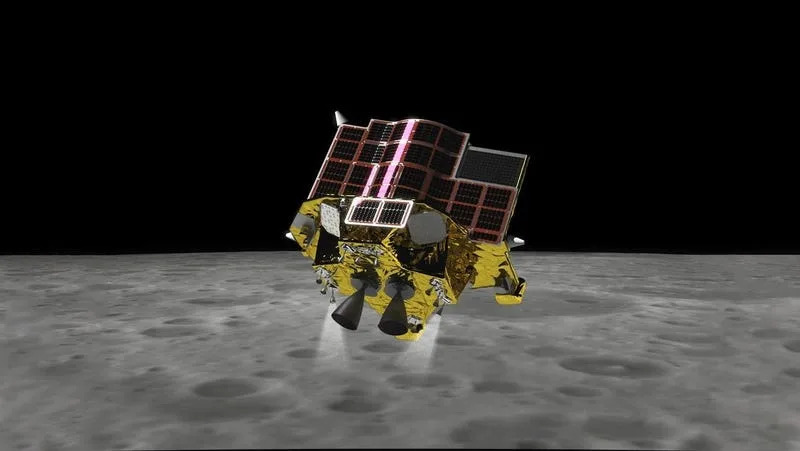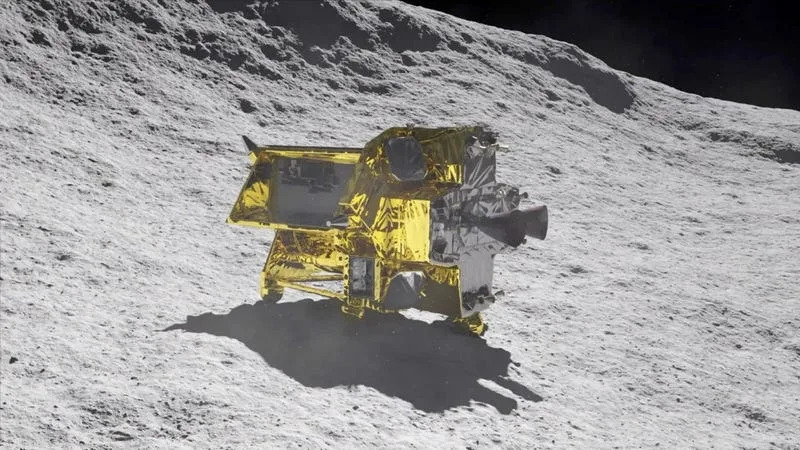A First-of-Its-Kind 'Pinpoint' Moon Landing Could Happen This Week
George Dvorsky
Wed, January 17, 2024

Depiction of SLIM performing its lunar landing.
We’re still reeling from last week’s Astrobotic failure, in which a catastrophic propellant leak rendered the Peregrine lunar lander incapable of completing its Moon landing mission. It’s not the outcome we were hoping for, but the global space community doesn’t have to wait long for another opportunity at lunar exploration success: Japan’s SLIM is slated to attempt an innovative lunar landing this Friday morning.
Scheduled to land on January 19 at 10:20 a.m. EST (Saturday, January 20 at 12:20 a.m. JST), the SLIM, or Smart Lander for Investigating Moon, mission marks a significant milestone for the Japan Aerospace Exploration Agency. In addition to it being JAXA’s inaugural lunar landing attempt, it’s also serving as a pioneering testbed for cutting-edge precision landing technologies.

Depiction of SLIM on the Moon.
JAXA began the SLIM project back in 2013, with the aim of kickstarting Japan’s lunar exploration capabilities. The Planetary Society says it cost about $120 million to develop SLIM. It weighs about 440 pounds (200 kilograms) when dry and approximately 1,540 pounds (700 kg) when fueled for launch.
The space agency is seeking to place the lander, built by Mitsubishi Electric, in the Shioli Crater, a 984-foot-wide (300-meter) impact basin. The 20-minute autonomous descent will begin at an altitude of 9.3 miles (15 kilometers), with SLIM traveling at a speed of 3,800 miles per hour (1,700 meters per second). The spacecraft is scheduled to land within a designated area measuring approximately 328 feet by 328 feet, or 100 meters by 100 meters.
According to reporter Jatan Mehta, China’s 2013 Chang’e 3 mission holds the current record for the most accurate Moon landing, whether robotic or human. Its landing ellipse size was 3.73 by 3.73 miles (6 by 6 kilometers), and it impressively landed just 292 feet (89 meters) from its target point. By comparison, India’s 2023 Chandrayaan 3 mission had a landing ellipse that spanned 2.49 by 1.55 miles (4 by 2.5 kilometers). It successfully touched down approximately 1,148 feet (350 meters) away from the designated target spot.
JAXA’s objectives for the SLIM mission include developing a lightweight spacecraft system, testing vision-based navigation essential for high-precision landings, and conducting lunar surface operations to gather knowledge for future exploration.
SLIM encompasses a suite of advanced technologies crucial for a pinpoint lunar landing. These include an advanced guidance and navigation system to ensure trajectory accuracy (including pre-loaded maps, radar, and image processing algorithms) and a high-performance propulsion system for the fine-tuning of approach vectors (i.e., adjusting the spacecraft’s direction and speed) as it approaches the lunar surface. Its hazard detection and avoidance technology will be key to ensuring a safe touchdown.
SLIM is also equipped with tools for studying the lunar surface, including two tiny rovers: Lunar Excursion Vehicle (LEV) 1 and 2. LEV-1 has a camera and is designed to hop on the lunar surface, while Lev-2, also known as SORA-Q, is a tiny transformable robot developed by JAXA, Tomy (the company behind the earliest Transformers toys), Sony Group, and Doshisha University. SLIM is not expected to survive beyond a single lunar day, the equivalent of approximately 14 Earth days, as it wasn’t designed to endure the harsh conditions of a lunar night.
JAXA began landing preparations on January 10, with a successful orbital adjustment on January 14. SLIM is now in a stable 373-mile (600-kilometer) orbit around the Moon, with all systems performing as expected. The upcoming landing is a critical next step for this mission, with JAXA’s control team ready to make real-time adjustments if necessary.
SLIM, should it be successful, will mark an important milestone in space exploration. By enabling high-precision landings, it will enhance our ability to study and understand celestial bodies with unparalleled accuracy. This achievement not only promises more effective research, it also lays the groundwork for future missions that can delve even deeper into the mysteries of the cosmos.
Gizmodo
No comments:
Post a Comment